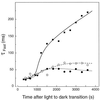Nonphotochemical reduction of the plastoquinone pool in sunflower leaves originates from chlororespiration
- PMID: 9536037
- PMCID: PMC35027
- DOI: 10.1104/pp.116.4.1209
Nonphotochemical reduction of the plastoquinone pool in sunflower leaves originates from chlororespiration
Abstract
We investigated the relationship between nonphotochemical plastoquinone reduction and chlororespiration in leaves of growth-chamber-grown sunflower (Helianthus annuus L.). Following a short induction period, leaves of previously illuminated sunflower showed a substantially increased level of minimal fluorescence following a light-to-dark transition. This increase in minimal fluorescence was reversed by far-red illumination, inhibited by rotenone or photooxidative methyl viologen treatment, and stimulated by fumigation with CO. Using flash-induced electrochromic absorption-change measurements, we observed that the capacity of sunflower to reduce plastoquinone in the dark influenced the activation state of the chloroplast ATP synthase, although chlororespiratory transmembrane electrochemical potential formation alone does not fully explain our observations. We have added several important new observations to the work of others, forming, to our knowledge, the first strong experimental evidence that chlororespiratory, nonphotochemical plastoquinone reduction and plastoquinol oxidation occur in the chloroplasts of higher plants. We have introduced procedures for monitoring and manipulating chlorores-piratory activity in leaves that will be important in subsequent work aimed at defining the pathway and function of this dark electron flux in higher plant chloroplasts.
Figures






Similar articles
-
Non-photochemical quenching of chlorophyll a fluorescence by oxidised plastoquinone: new evidences based on modulation of the redox state of the endogenous plastoquinone pool in broken spinach chloroplasts.Biochim Biophys Acta. 2005 Feb 17;1706(3):239-49. doi: 10.1016/j.bbabio.2004.11.005. Biochim Biophys Acta. 2005. PMID: 15694352
-
An HPLC-based method of estimation of the total redox state of plastoquinone in chloroplasts, the size of the photochemically active plastoquinone-pool and its redox state in thylakoids of Arabidopsis.Biochim Biophys Acta. 2006 Dec;1757(12):1669-75. doi: 10.1016/j.bbabio.2006.08.004. Epub 2006 Aug 10. Biochim Biophys Acta. 2006. PMID: 16989770
-
Stromal over-reduction by high-light stress as measured by decreases in P700 oxidation by far-red light and its physiological relevance.Plant Cell Physiol. 2005 May;46(5):775-81. doi: 10.1093/pcp/pci084. Epub 2005 Mar 23. Plant Cell Physiol. 2005. PMID: 15788424
-
Kinetics of plastoquinol oxidation by the Q-cycle in leaves.Biochim Biophys Acta. 2016 Jun;1857(6):819-30. doi: 10.1016/j.bbabio.2016.03.032. Epub 2016 Apr 4. Biochim Biophys Acta. 2016. PMID: 27056771
-
Chlororespiration.Philos Trans R Soc Lond B Biol Sci. 2000 Oct 29;355(1402):1541-7. doi: 10.1098/rstb.2000.0714. Philos Trans R Soc Lond B Biol Sci. 2000. PMID: 11128007 Free PMC article. Review.
Cited by
-
Mercury inhibits the non-photochemical reduction of plastoquinone by exogenous NADPH and NADH: evidence from measurements of the polyphasic chlorophyll a fluorescence rise in spinach chloroplasts.Photosynth Res. 2002;74(1):37-50. doi: 10.1023/A:1020884500821. Photosynth Res. 2002. PMID: 16228543
-
Heterogeneity of Photosystem I reaction centers in barley leaves as related to the donation from stromal reductants.Photosynth Res. 2001;70(3):273-9. doi: 10.1023/A:1014741814581. Photosynth Res. 2001. PMID: 16252172
-
IMMUTANS does not act as a stress-induced safety valve in the protection of the photosynthetic apparatus of Arabidopsis during steady-state photosynthesis.Plant Physiol. 2006 Oct;142(2):574-85. doi: 10.1104/pp.106.085886. Epub 2006 Aug 4. Plant Physiol. 2006. PMID: 16891546 Free PMC article.
-
Propagation of photoinduced signals with the cytoplasmic flow along Characean internodes: evidence from changes in chloroplast fluorescence and surface pH.Eur Biophys J. 2013 Jun;42(6):441-53. doi: 10.1007/s00249-013-0895-z. Epub 2013 Mar 7. Eur Biophys J. 2013. PMID: 23467782
-
Why leaves turn red in autumn. The role of anthocyanins in senescing leaves of red-osier dogwood.Plant Physiol. 2001 Oct;127(2):566-74. Plant Physiol. 2001. PMID: 11598230 Free PMC article.
References
-
- Aristarkhov AI, Nikandrov VV, Krasnovskii AA. Ascorbate permeability of chloroplast thylakoid membrane; reduction of plastoquinone and cytochrome f. Biokhimiya. 1987;52:1729–1808.
-
- Asada K, Heber U, Schreiber U. Pool size of electrons that can be donated to P700+, as determined in intact leaves: donation of P700+ from stromal components via the intersystem chain. Plant Cell Physiol. 1992;33:927–932.
-
- Bendall DS, Manasse RS. Cyclic photophosphorylation and electron transport. Biochim Biophys Acta. 1995;1229:23–38.
-
- Bennoun P. Effects of mutations and of ionophores on chlororespiration in Chlamydomonas reinhardtii. FEBS Lett. 1993;156:363–365.
LinkOut - more resources
Full Text Sources

